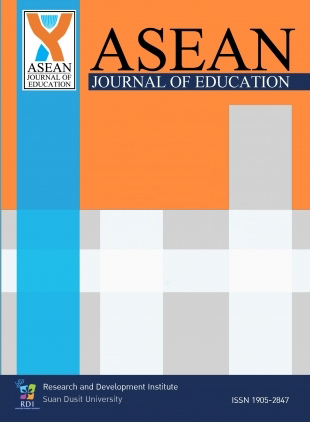The Role of Communicative Adaptability in Lowering Intercultural Communication Apprehension of the Thai International College Students
Abstract
The purpose of this study is to analyze the role of communicative adaptability (CA) in lowering intercultural communication apprehension (ICA) as well as exploring which aspects of CA that significantly contribute in lowering ICA among Thai international college students during interacting with a foreign instructor in a classroom. Participants in the study consist of 333 Thai college students who were studying at Assumption University, which is one of the leading private international universities in Thailand where all courses are taught in English. The data were collected at the end of the semester. Partial least squares regression is employed to analyze the relationship between all six aspects of CA (social experience, social composure, social confirmation, appropriate disclosure, articulation, and wit) and ICA. In addition, some characteristics of students including age, gender, student classification, grade point average, frequency of English Language used and frequency of enrollment are also included in the analysis. Overall, the findings of the study indicate that there are two aspects of CA: social composure and articulation; that are significantly associated with lowering ICA. Hence, this study confirms that the Thai sample students who are well equipped with social composure and articulation tend to experience less anxiety and feel more comfortable to communicate in English with foreigners particularly with their foreign instructors.
References
Bunrueng, P. (2008). Anxiety in studying English for Communication of Loei Rajabhat University Students. Paper presented at the International Conference of Educational Research (ICER) on Learning Communities for Sustainable Development.
Chin, W., & Newsted, P. (1999). Structural Equation Modeling Analysis with Small Samples Using Partial Least Squares. In R. Hoyle (Ed.), Statistical Strategies for Small Sample Research (pp. 307-334): Sage Publications.
Duran, R. L. (1983). Communicative adaptability: A measure of social communicative competence. Communication Quarterly, 31, 320-326.
Duran, R. L. (1992). Communicative adaptability: A Review of conceptualization and measurement. Communication Quarterly, 40, 253-268.
Falk, R. F. & Miller, N. B. (1992). A primer for soft modeling. Akron, OH: University of Akron Press.
Field, Andy (2013) Discovering statistics using IBM SPSS Statistics: and sex and drugs and rock ‘n’ roll (4th edition). Sage, London. ISBN 9781446249178
Hecht, M. L. (1978). The conceptualization and measurement of interpersonal communication satisfaction. Human Communication Research, 4, 253-264.
Jung, H., & McCroskey, J. (2004). Communication apprehension in a first language and self-perceived competence as predictors of communication apprehension in a second language: A study of speakers of English as a second language. Communication Quarterly, 52, 170-181.
Kaeokallaya Apaibanditkul. (2006). The anxiety of international Thai students in an English speaking context. (Unpublished doctoral dissertation). Retrived from ProQuest Dissertations & Thesis fulltext. (UMI No.3229826)
Khamkhien, A. (2010). Teaching English speaking and English speaking tests in the Thai context: A reflection from Thai perspective. English Language Teaching, 3(2), 184-190.
Kelly, C. W., Chase, L. J. & Wiemann, J. M. (1979). Interpersonal competence: Conceptualization, measurement, and future consideration. Paper presented at the Speech Communication Association Convention, San Antonio, Texas,.
Kock, N. (2015). WarpPLS 5.0 User Manual. Laredo, TX: ScriptWarp Systems.
Kock, N., & Lynn, G. S. (2012). Lateral collinearity and misleading results in variance-based SEM: An illusion and recommendations. Journal of the Association for information Systems, 13(7), 546-580.
Kline, R. B. (2004). Beyond significance testing: Reforming data analysis methods in behavioral research. Washington, D.C.: American Psychological Association.
McCroskey, J. C., & Anderson, J. F. (1976). Relationship between communication apprehension and academic achievement among college students. Human Communication Research, 3, 73-81.
McCroskey, J. C., Booth-Butterfield, S., & Payne, S. K. (1989). The impact of communication apprehension on college student retention and success. Communication Quarterly, 37, 100-107.
McCroskey, J. C., & Richmond, V. P. (1988). Communication apprehension and small group communication. Small Group Communication: A Reader, 5, 405-420.
Nunnally, J. C. (1978). Psychometric theory (2rd ed.). N.Y.: McGraw-Hill
Neuliep, J. W., & McCroskey, J. C., (1997). The development of intercultural and interethnic communication apprehension scales, Communication Research Reports, 14(2), 145-156.
Neuliep, J. W., & Ryan, D. (1998). The influence of intercultural communication apprehension and and socio-communicative orientation on uncertainty reduction during initial initial cross-cultural interaction. Communication Quarterly, 46, 88-99.
Tsiplakides, I., & Keramida, A. (2009). Helping students overcome foreign language speaking anxiety in the English classroom: Theoretical issues and practical recommendations. 2(4),39-44. doi: http://dx.doi.org/10.5539/ies.v2n4p39
Wieman, J. M. (1977). Explication and test of a model of communicative competence. Human Communication Research, 3, 195-213.
Zakahi, W. R., & Duran, R. L. (1984). Attraction, communicative competence, and communication satisfaction. Communication Research Reports, 1, 54-57.
Downloads
Published
How to Cite
Issue
Section
License
1 All articles will undergo a formal peer-review. A panel of experts from within or without the university will examine the article; approval from a minimum of two experts is required for publication. Revisions posed by the experts must be completed by the research prior to publication.
2 Once published in the ASEAN Journal of Education, the article becomes intellectual property of Suan Dusit University. Duplication, in full or part, requires permission from Suan Dusit University.
3 Excluding errors incurred during printing, author(s) are responsible for the content of their articles.






